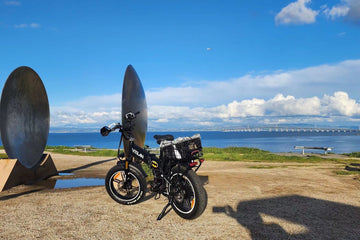An electric-assist bicycle, often called an E-Bike, is a popular form of transportation that combines a traditional bicycle with electric assistance, providing the rider with extra power to make riding easier and more enjoyable. Here’s an overview of the basics of e-bikes:
1. Working principle:
The working principles of E-Bike are usually divided into two methods: pedal-assist and manual control (throttle-based). In a pedal assist system, sensors detect how hard the rider is pedaling and activate an electric motor to provide additional power. The manual control system allows the rider to control the electric motor using the throttle on the handlebars, similar to a motorcycle.
2. Main components:
⭐️Electric motor: The core component of the E-Bike, usually installed in the hub of the wheel (hub motor) or integrated into the base bracket (mid-mounted motor). It provides the power needed to assist the rider's pedaling.
⭐️Battery: The E-Bike is powered by rechargeable lithium-ion batteries, which store the energy needed to operate the electric motor. Battery capacity is measured in watt-hours (Wh), and the greater the capacity, the longer the range.
⭐️Controller: The controller manages the flow of electrical energy from the battery to the electric motor, controlling speed and power output.
⭐️Sensor: Sensors, such as cadence sensor and torque sensor, detect the rider's pedaling frequency and intensity, so that the motor can provide auxiliary power according to the rider's effort.
⭐️Display/Control Unit: E-Bikes often feature an LCD display or control unit on the handlebars, allowing the rider to select different power levels, monitor battery status and control other functions.
3. Types of E-Bike:
⭐️Class 1 (Class 1): Pedal assist E-Bike only provides assistance when the rider is pedaling. Once the bicycle reaches a certain speed (usually about 20 miles/hour or 32 kilometers/hour), the assistance stops. Generally allowed on bike paths and trails.
⭐️Class 2 (Class 2): E-Bike equipped with a throttle, allowing the rider to control the electric motor without pedaling. Even without stepping, it can provide assistance.
⭐️Class 3: Similar to a Class 1 E-Bike, but with a higher top speed (usually around 28 mph or 45 km/h).
⭐️Class 4 (Four Category): High-power E-Bikes that typically exceed the speed limits of Class 3 and may be subject to different regulations.
E-Bikes are popular for their versatility, environmental friendliness and convenience in providing a variety of uses, including commuting, recreation and cargo transportation. The electric assist function can be adjusted to the rider's preference, providing a customizable and efficient riding experience.











